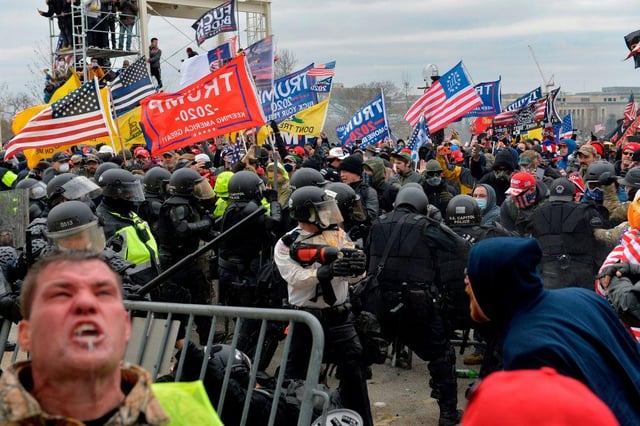Ted Cruz faces fierce blowback after his objection to Joe Biden’s victory and riot at the U.S. Capitol
/https://static.texastribune.org/media/files/49768b4e6fab6c42ab333783f10a8f04/Ted%20Cruz%20Capitol%20Hill%20REUTERS%20.jpg)
Two nights before the Electoral College certification in Congress, Ted Cruz was in vintage form.
The junior U.S. senator from Texas was calling in to a friendly conservative radio host — Mark Levin — and setting up Wednesday’s vote to be the kind of intraparty line in the sand that has powered his political rise.
By then, Senate Majority Leader Mitch McConnell had made clear that he opposed objections to certifying Joe Biden’s election as the next president. But Cruz and 10 other GOP senators announced they would still object unless Congress agreed to an “emergency audit” of the presidential election results.
Cruz told Levin that there were some conservatives “who in good conscience” disagree with his view of Congress’ role in certifying the presidential election results, and that he had talked to them and did not fault them. On the other hand, Cruz said, there were “some Republicans who are not conservatives but who are piously and self-righteously preening” when it comes to the issue.
In spearheading the group of objectors, Cruz arguably upstaged U.S. Sen. Josh Hawley, R-Missouri, who announced his plan to object three days earlier — and, like Cruz, is considered a potential 2024 presidential contender.
But on Wednesday, what Cruz might have thought was a savvy political play took an alarming turn: Supporters of President Donald Trump stormed and ransacked the U.S. Capitol while lawmakers were considering Cruz’s objection. Three people suffered medical emergencies during the siege and died; their deaths were in addition to another woman who was shot by a Capitol police officer.
Cruz denounced the violence but incurred a fierce backlash from critics in both parties, who said his drive to question the election results — and appease the president and his supporters ahead of a possible 2024 run — helped fan the flames of anger among Trump supporters. Prominent Texas Democrats called for him to resign. Many others suggested he’d played an inciting role in one of the darkest days in modern American history.
Politically, it was a high-stakes distillation of GOP tactics in the era of Trump.
In recent months, Cruz has positioned himself as one of the most prominent and vocal Trump supporters casting doubt on the election. Two days after Election Day, Cruz charged that Philadelphia officials were not allowing election observers to watch the counting of votes in the swing state, even though Trump’s lawyers conceded that they had been allowed in the room.
In December, Trump asked Cruz if he would be willing to argue a long shot case filed by Attorney General Ken Paxton seeking to invalidate the election results in states like Pennsylvania in the event that it reached the U.S. Supreme Court. (Cruz agreed, but the high court ultimately said Texas did not have standing to bring the case.)
And in the days ahead of Wednesday’s certification, Cruz raised concerns about how many people believed fraud had occurred in the election, without acknowledging the role he had played in encouraging those beliefs
“We’ve seen in the last two months unprecedented allegations of voter fraud,” Cruz said in an early January interview on Fox News. “And that’s produced a deep, deep distrust of our democratic process across the country. I think we in Congress have an obligation to do something about that.”
But people in both parties have questioned his motives.
“Proposing a commission at this late date — which has zero chance of becoming reality — is not effectively fighting for President Trump,” U.S. Sen. Lindsey Graham, R-South Carolina, tweeted. “It appears to be more of a political dodge than an effective remedy.”
As people stormed the Capitol building, Cruz insisted on Twitter that violence “is ALWAYS wrong” and called the attack a “despicable act of terrorism and a shocking assault on our democratic system.”
“Those engaged in violence are hurting the cause they say they support,” he said.
He did not, however, withdraw his objections to the Election Day results.
It didn’t help that Cruz on Wednesday was fundraising off his Electoral College challenge, with some money-seeking texts hitting phones as Trump supporters wreaked havoc at the Capitol. (An aide to Cruz said the messages were sent “from a firm” and not approved by Cruz to be sent.) To Cruz’s critics, including those within his own party, it was emblematic of the kind of naked political ambition that they have long abhorred about him.
“The Cruz effort had nothing to do with making some determination of whether or not there was fraud to reverse the outcome of the election and only to do with 2024 and the presidential primary,” said Jerry Patterson, a Republican former state land commissioner who is open about his unhappiness with Trump, but conceded that he’s voted for Cruz in past elections.
“That’s why I could never get back into politics anymore. I’m sick and tired of the bullshit. And that’s what it was,” he said.
The episode not only gave fodder to Cruz’s longtime intraparty detractors but also fellow Republicans.
“You have some senators who, for political advantage, were giving false hope to their supporters [and] misleading them to believe somehow yesterday’s actions in Congress could reverse the results of the election,” U.S. Sen. Tom Cotton, a Republican from Arkansas who is also seen as a possible 2024 contender, said in a TV appearance on Fox without directly naming Cruz. “That was never going to happen yet these senators, as insurrectionists literally stormed the Capitol, were sending out fundraising emails.”
U.S. Sen. Mitt Romney, the GOP’s 2012 nominee for president, raised similar frustrations on the Senate floor Wednesday night, without mentioning Cruz or other objectors by name
“I ask my colleagues: Do we weigh our own political fortunes more heavily than we weigh the strength of our Republic, the strength of our democracy and the cause of freedom? What is the weight of personal acclaim compared to the weight of conscience?”
To be clear, Cruz received backup from his own party. While his initial coalition did not hold, he was still joined by several colleagues in objecting to the certification of the results in Arizona and Pennsylvania. Dozens of House members, including many Texans, also objected in both cases.
The state’s senior senator, John Cornyn, split decisively from Cruz, announcing he would not object in a lengthy letter to Texans on Tuesday, specifically pooh-poohing Cruz’s emergency audit proposal. That contrast in particular heartened some Cruz supporters.
“Ted Cruz will be a stronger force in the Texas GOP than John Cornyn because of the way he has handled the last 30 days and because he doesn’t answer to the same political elite that Cornyn does,” said Luke Macias, a consultant for some of the Texas Legislature’s farthest-right members. “Democrats’ insane calls for Cruz to step down have only made him politically stronger.”
Democrats, meanwhile, were apoplectic over his role. Two of the state’s best-known Democrats, Joaquin and Julián Castro, called on Cruz to resign, as did the state Democratic Party. Cruz’s old nemesis Beto O’Rourke emailed supporters calling for “accountability and consequence” against the Texas senator, who defeated O’Rourke in a Senate race in 2018.
“Sen. Cruz, you must accept responsibility for how your craven, self-serving actions contributed to the deaths of four people yesterday. And how you fundraised off this riot,” tweeted U.S. Rep. Alexandria Ocasio-Cortez, D-New York. “Both you and Senator Hawley must resign. If you do not, the Senate should move for your expulsion.”
In Cruz’s Houston hometown, activists lined the streets on Thursday, calling for his resignation while standing outside of a downtown skyscraper that houses one of Cruz’s offices.
But to detractors asking him to leave Congress, Cruz responded curtly Thursday afternoon, “Sorry, I ain’t going anywhere.”
While Cruz himself doesn’t appear to have any regrets for his role in inciting an insurrection — on Thursday he said he would do it all over again if he had to — his colleagues might not easily forgive under a new presidential administration.
Patterson, for one, thinks Cruz’s future political prospects hinge on where Republicans go in the next four years — and whether they remain loyal to Trump.
“There was a reset yesterday of politics in America — at least I hope and pray there was,” Patterson said.
Disclosure: The University of Houston has been a financial supporter of The Texas Tribune, a nonprofit, nonpartisan news organization that is funded in part by donations from members, foundations and corporate sponsors. Financial supporters play no role in the Tribune's journalism. Find a complete list of them here.















 Participating students Ali O’ Donoghue and Eilís Mullane, students from St Brigid’s Secondary School, Killarney, Co Kerry and their project ‘Vertical Farming -The Future of Healthy Schools’.
Participating students Ali O’ Donoghue and Eilís Mullane, students from St Brigid’s Secondary School, Killarney, Co Kerry and their project ‘Vertical Farming -The Future of Healthy Schools’.